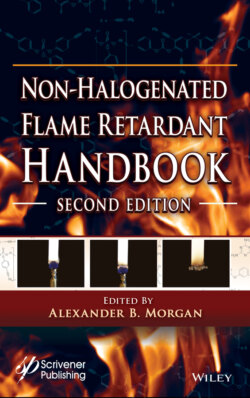Читать книгу Non-halogenated Flame Retardant Handbook - Группа авторов - Страница 41
2.12 Conclusions and Further Trends
ОглавлениеThe growth of phosphorus-based flame retardants as a class is often attributed to the replacement of halogenated flame retardants which is disputable. Although there is a general market trend to halogen-free flame retardants mostly dictated by original equipment manufacturers (OEMs) for their “green image”, there are many areas where halogenated flame retardants cannot be replaced due to technical reasons. Since phosphorus flame retardants possess gas phase and condensed phase modes of flame-retardant action with the gas phase being mostly underutilized there are good prospects for the development of new FRs with mostly gas phase activity or the discovery of new synergistic combinations. Because phosphorus FRs are selectively active in only a handful of highly charrable and heteroatomic polymers there is a need for the development of more universal flame retardants. This research can progress either by development of new highly efficient and hydrolytically stable intumescent systems or of highly efficient gas phase active FRs or of a combination of both. Plastics containing phosphorus FRs are poorly recyclable and so there is interest in more hydrolytically and thermally stable phosphorus flame retardants that are favorable to recycling.
Phosphorus flame retardants have not escaped environmentalist concerns and there are a growing number of academic publications that detect organophosphorus flame retardants in the environment. However, it would be an error to say that phosphorus flame retardants are found more often because they replace halogens. Mostly relatively mobile organophosphorus flame retardants that were detected have been in use for at least half a century. Specific organophosphorus compounds raised sufficient concerns to warrant their discontinuance, but this was not generic to the entire class. Following the general trend of the flame-retardant industry towards polymeric and reactive products which show less negative effects to the final products and minimal exposure to humans and the environment, phosphorus flame retardants will follow this general strategy. Trends in the research and development of phosphorus flame retardants have been in the direction of less volatile, less toxic, and more stable compounds, and where feasible, in the direction of built-in phosphorus structures. At the same time, the existing phosphorus flame retardants are finding increased exploitation in the form of mixtures with synergists and adjuvants.
